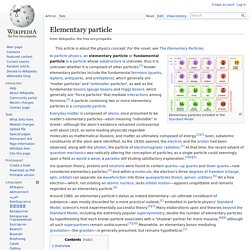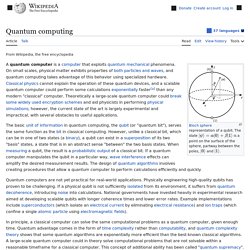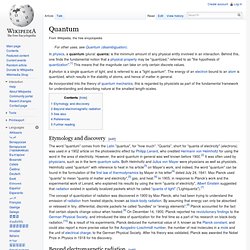

Elementary particle. In particle physics, an elementary particle or fundamental particle is a particle whose substructure is unknown, thus it is unknown whether it is composed of other particles.[1] Known elementary particles include the fundamental fermions (quarks, leptons, antiquarks, and antileptons), which generally are "matter particles" and "antimatter particles", as well as the fundamental bosons (gauge bosons and Higgs boson), which generally are "force particles" that mediate interactions among fermions.[1] A particle containing two or more elementary particles is a composite particle.

Everyday matter is composed of atoms, once presumed to be matter's elementary particles—atom meaning "indivisible" in Greek—although the atom's existence remained controversial until about 1910, as some leading physicists regarded molecules as mathematical illusions, and matter as ultimately composed of energy.[1][2] Soon, subatomic constituents of the atom were identified.
Overview[edit] Main article: Standard Model. Quantum computer. Study of a model of computation Quantum computing is the use of quantum phenomena such as superposition and entanglement to perform computation.

Computers that perform quantum computations are known as quantum computers.[1]:I-5 Quantum computers are believed to be able to solve certain computational problems, such as integer factorization (which underlies RSA encryption), substantially faster than classical computers. The study of quantum computing is a subfield of quantum information science. Quantum. A photon is a single quantum of light, and is referred to as a "light quantum".

The energy of an electron bound to an atom is quantized, which results in the stability of atoms, and hence of matter in general. As incorporated into the theory of quantum mechanics, this is regarded by physicists as part of the fundamental framework for understanding and describing nature at the smallest length-scales. Etymology and discovery[edit] The word "quantum" comes from the Latin "quantus", for "how much". "Quanta", short for "quanta of electricity" (electrons) was used in a 1902 article on the photoelectric effect by Philipp Lenard, who credited Hermann von Helmholtz for using the word in the area of electricity. TEDxCaltech - Charlie Marcus - Nanoelectronics and Quantum Computation. Controlled Quantum Levitation on a Wipe'Out Track. Quantum levitation. Perpetuum mobile, free energy 1/2. Controlled Quantum Levitation on a Wipe'Out Track.